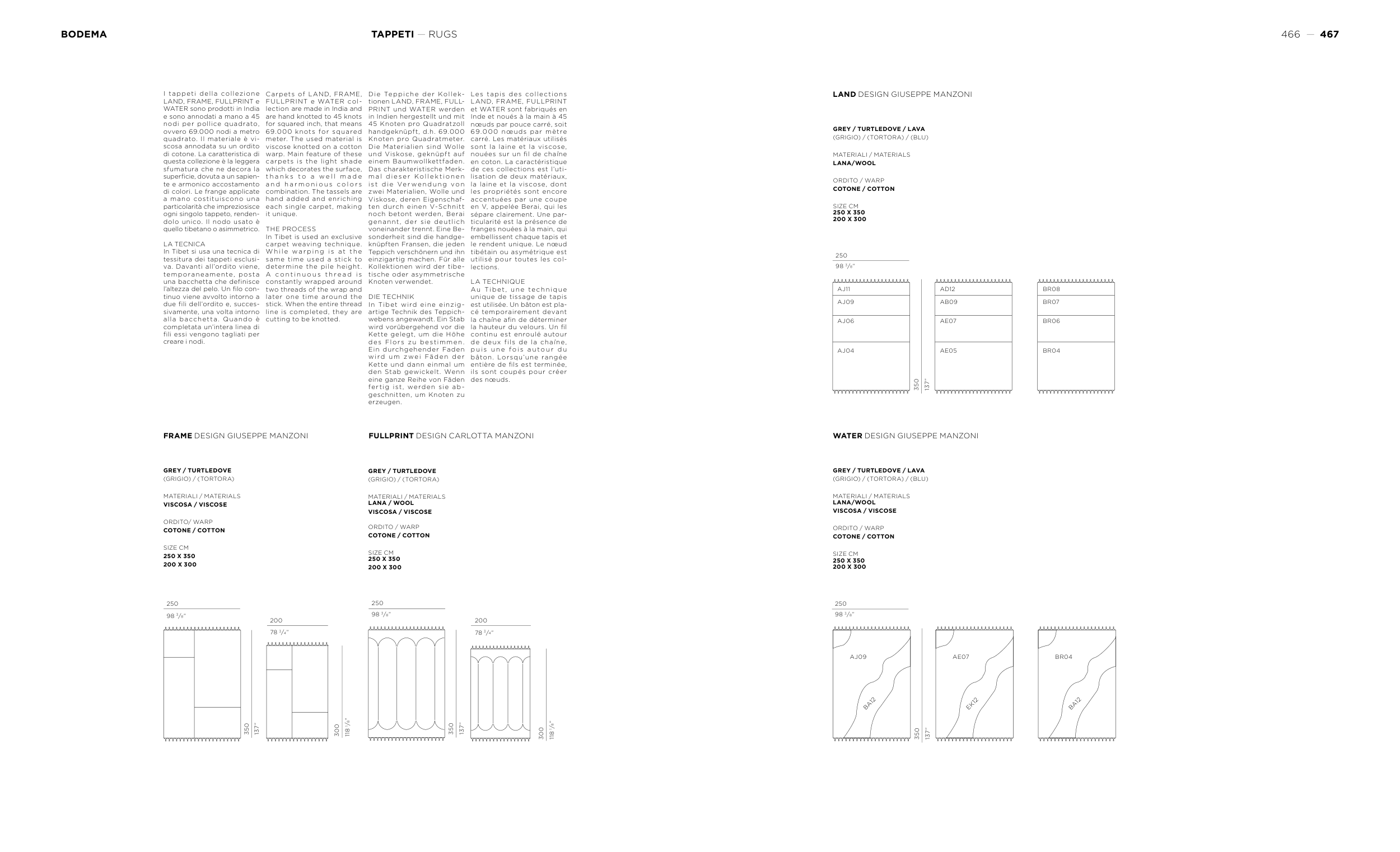250
98 3/8”
200
78 3/4”
350
137”
300
118 1/8”
GREY / TURTLEDOVE
(GRIGIO) / (TORTORA)
MATERIALI / MATERIALS
VISCOSA / VISCOSE
ORDITO/ WARP
COTONE / COTTON
SIZE CM
250 X 350
200 X 300
GREY / TURTLEDOVE
(GRIGIO) / (TORTORA)
MATERIALI / MATERIALS
LANA / WOOL
VISCOSA / VISCOSE
ORDITO / WARP
COTONE / COTTON
SIZE CM
250 X 350
200 X 300
250
98 3/8”
200
78 3/4”
350
137”
300
118 1/8”
GREY / TURTLEDOVE / LAVA
(GRIGIO) / (TORTORA) / (BLU)
MATERIALI / MATERIALS
LANA/WOOL
ORDITO / WARP
COTONE / COTTON
SIZE CM
250 X 350
200 X 300
AJ11
AD12
BR08
AB09
BR07
AE07
BR06
AE05
BR04
AJ09
AJ06
AJ04
GREY / TURTLEDOVE / LAVA
(GRIGIO) / (TORTORA) / (BLU)
MATERIALI / MATERIALS
LANA/WOOL
VISCOSA / VISCOSE
ORDITO / WARP
COTONE / COTTON
SIZE CM
250 X 350
200 X 300
AJ09
AE07
BR04
BA12
EK12
BA12
250
250
98 3/8”
98 3/8”
350
350
137”
137”
FRAME DESIGN GIUSEPPE MANZONI
I tappeti della collezione
LAND, FRAME, FULLPRINT e
WATER sono prodotti in India
e sono annodati a mano a 45
nodi per pollice quadrato,
ovvero 69.000 nodi a metro
quadrato. Il materiale è vi-
scosa annodata su un ordito
di cotone. La caratteristica di
questa collezione è la leggera
sfumatura che ne decora la
superficie, dovuta a un sapien-
te e armonico accostamento
di colori. Le frange applicate
a mano costituiscono una
particolarità che impreziosisce
ogni singolo tappeto, renden-
dolo unico. Il nodo usato è
quello tibetano o asimmetrico.
LA TECNICA
In Tibet si usa una tecnica di
tessitura dei tappeti esclusi-
va. Davanti all’ordito viene,
temporaneamente, posta
una bacchetta che definisce
l’altezza del pelo. Un filo con-
tinuo viene avvolto intorno a
due fili dell’ordito e, succes-
sivamente, una volta intorno
alla bacchetta. Quando è
completata un’intera linea di
fili essi vengono tagliati per
creare i nodi.
Carpets of LAND, FRAME,
FULLPRINT e WATER col-
lection are made in India and
are hand knotted to 45 knots
for squared inch, that means
69.000 knots for squared
meter. The used material is
viscose knotted on a cotton
warp. Main feature of these
carpets is the light shade
which decorates the surface,
t h a n k s t o a w e l l m a d e
a n d h a r m o n i o u s c o l o r s
combination. The tassels are
hand added and enriching
each single carpet, making
it unique.
THE PROCESS
In Tibet is used an exclusive
carpet weaving technique.
W h i l e wa r p i n g i s a t t h e
same time used a stick to
determine the pile height.
A c o n t i n u o u s t h r e a d i s
constantly wrapped around
two threads of the wrap and
later one time around the
stick. When the entire thread
line is completed, they are
cutting to be knotted.
Die Teppiche der Kollek-
tionen LAND, FRAME, FULL-
PRINT und WATER werden
in Indien hergestellt und mit
45 Knoten pro Quadratzoll
handgeknüpft, d.h. 69.000
Knoten pro Quadratmeter.
Die Materialien sind Wolle
und Viskose, geknüpft auf
einem Baumwollkettfaden.
Das charakteristische Merk-
m a l d i e s e r Ko ll e k ti o n e n
is t di e Ve r we n d u n g vo n
zwei Materialien, Wolle und
Viskose, deren Eigenschaf-
ten durch einen V-Schnitt
noch betont werden, Berai
genannt, der sie deutlich
voneinander trennt. Eine Be-
sonderheit sind die handge-
knüpften Fransen, die jeden
Teppich verschönern und ihn
einzigartig machen. Für alle
Kollektionen wird der tibe-
tische oder asymmetrische
Knoten verwendet.
DIE TECHNIK
In Tibet wird eine einzig-
artige Technik des Teppich-
webens angewandt. Ein Stab
wird vorübergehend vor die
Kette gelegt, um die Höhe
des Flors zu bestimmen.
Ein durchgehender Faden
wird um z wei Fäden der
Kette und dann einmal um
den Stab gewickelt. Wenn
eine ganze Reihe von Fäden
fertig ist, werden sie ab-
geschnitten, um Knoten zu
erzeugen.
Les tapis des collections
LAND, FRAME, FULLPRINT
et WATER sont fabriqués en
Inde et noués à la main à 45
nœuds par pouce carré, soit
69.000 nœuds par mètre
carré. Les matériaux utilisés
sont la laine et la viscose,
nouées sur un fil de chaîne
en coton. La caractéristique
de ces collections est l’uti-
lisation de deux matériaux,
la laine et la viscose, dont
les propriétés sont encore
accentuées par une coupe
en V, appelée Berai, qui les
sépare clairement. Une par-
ticularité est la présence de
franges nouées à la main, qui
embellissent chaque tapis et
le rendent unique. Le nœud
tibétain ou asymétrique est
utilisé pour toutes les col-
lections.
LA TECHNIQUE
Au Tibet, une technique
unique de tissage de tapis
est utilisée. Un bâton est pla-
cé temporairement devant
la chaîne afin de déterminer
la hauteur du velours. Un fil
continu est enroulé autour
de deux fils de la chaîne,
p u i s u n e f o i s a u to u r d u
bâton. Lorsqu’une rangée
entière de fils est terminée,
ils sont coupés pour créer
des nœuds.
FULLPRINT DESIGN CARLOTTA MANZONI
LAND DESIGN GIUSEPPE MANZONI
WATER DESIGN GIUSEPPE MANZONI
BODEMA
466 — 467
TAPPETI — RUGS


